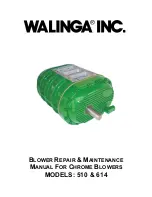
OMM-23-1009-page 3
3. Air Pressure and Suction:
In addition to the normal dangers of rotating machinery, the blower can present additional hazards from the suction or
pressure created at the blower inlet or discharge. Suction at the blower inlet can draw materials into the blower where
they become high velocity projectiles at the discharge and cause severe personal injury or death. It can also be
extremely dangerous to persons in close proximity to the inlet or discharge as the forces involved can overcome the
strength of most individuals.
NEVER OPERATE A BLOWER WITH A NON-DUCTED INLET AND/OR DISCHARGE. IF THE BLOWER INLET
AND/OR DISCHARGE IS NON-DUCTED, IT IS THE USERS RESPONSIBILITY TO INSTALL AN
INLET AND/OR DISCHARGE GUARD.
NO GUARANTEE OF ANY LEVEL OF SPARK RESISTANCE IS IMPLIED BY SPARK RESISTANT
CONSTRUCTION. IT HAS BEEN DEMONSTRATED THAT ALUMINUM IMPELLERS RUBBING ON RUSTY
STEEL CAN CAUSE HIGH INTENSITY SPARKS. AIR STREAM MATERIAL AND DEBRIS OR OTHER SYSTEM
FACTORS CAN ALSO CAUSE SPARKS.
4. Temperature:
Many blowers, blower components and all motors operate at temperatures that could burn someone if they come in
contact with them. If this potential hazard could exist in your installation, steps must be taken by the user to protect any-
one from coming in contact with this equipment.
5. Spark Resistance;
(Per AMCA Standard 99-0401-86 and ISO 13499)
6. Safety Accessories;
Guards:
All moving parts must be guarded to protect personnel. Safety requirements can vary, so the number and types of
guards required to meet company, local, state and OSHA regulations must be determined and specified by the actual
user or operator of the equipment.
NEVER start any blower without having all required safety guards properly installed. All blowers should be
checked on a regular schedule, for missing or damaged guards. If any required guards are found to be missing
or defective, the power to the blower should be immediately turned off and locked out in accordance with
OSHA regulations. Power to the blower should NOT be tuned back on until the required guards have been
repaired or replaced.
This blower can become dangerous due to a potential “windmill” effect, even though all electrical power has been
turned off or disconnected. The blower wheel should be
carefully
secured to prevent any rotational turning
BEFORE
working on any parts of the blower/motor assembly that could move.
7. Access or Inspection Doors:
II. INSTALLATION
A. Vibration:
Before any mounting method is selected, the user should be aware of the effects vibration will have on the blower,
motor and other parts. Improper blower installation can cause excessive vibration causing premature wheel and/or
motor bearing failure, that is not covered under warranty. Vibration eliminator pads, springs or bases should be properly
installed to prevent any blower vibration from transmitting to the foundation, support structure or ducting.
B. Mounting Methods:
1. Floor Mounted Units;
Centrifugal blowers should be mounted on a flat, level, concrete foundation weighing 2-3 times the weight of the com-
plete blower/motor assembly. It is recommended that the foundation be at least 6 inches larger than the base of the
blower. The foundation should include anchor bolts such as shown in
Fig. 1
on page 4. Place the blower over the
anchor bolts and shim under each bolt until the blower is level. After shimming, flat washers, lock washers and lock nuts
should be tightened at each anchor bolt. Any gaps between the blower base and the foundation should be grouted. If
the blower will be sitting on some type of vibration pads or mounts,
follow the recommended mounting procedures
supplied with the vibration elimination equipment.
WARNING
DANGER
I
SHUT THE BLOWER DOWN IMMEDIATELY IF THERE IS ANY SUDDEN INCREASE IN VIBRATION.
WARNING
NEVER OPEN ANY ACCESS OR INSPECTION DOORS WHILE THE BLOWER IS OPERATING. SERIOUS INJURY OR
DEATH COULD RESULT FROM THE AFFECTS OF AIR PRESSURE, AIR SUCTION OR MATERIAL THAT IS BEING
CONVEYED. DISCONNECT OR LOCK OUT POWER TO THE BLOWER AND LET THE BLOWER WHEEL COME TO A
COMPLETE STOP
BEFORE
OPENING ANY TYPE OF ACCESS OR INSPECTION DOOR.
DANGER

































